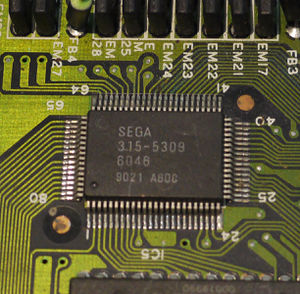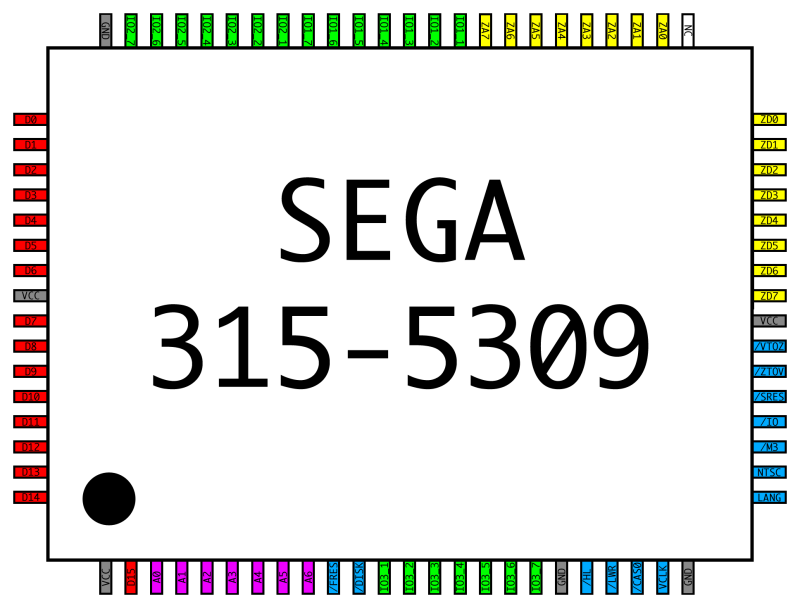315-5309
The 315-5309 is one of the two IO chips that can be found on early (usually pre-TMSS) Mega Drive models. It handles the version register, regions (part of the version register) as well as the three IO ports present on the Mega Drive.
Contents
Registers
The 315-5309 is a memory mapped peripheral mapped into memory starting at $A10000. Each address described below allows access to a specific 'register' of the chip that can control various aspects.
| Start | End | |
|---|---|---|
| $A10001 | $A10001 | Version register |
| $A10003 | $A10003 | Data 1 |
| $A10005 | $A10005 | Data 2 |
| $A10007 | $A10007 | Data 3 |
| $A10009 | $A10009 | Control 1 |
| $A1000B | $A1000B | Control 2 |
| $A1000D | $A1000D | Control 3 |
| $A1000F | $A1000F | TxD 1 |
| $A10011 | $A10011 | RxD 1 |
| $A10013 | $A10013 | Serial Control 1 |
| $A10015 | $A10015 | TxD 2 |
| $A10017 | $A10017 | RxD 2 |
| $A10019 | $A10019 | Serial Control 2 |
| $A1001B | $A1001B | TxD 3 |
| $A1001D | $A1001D | RxD 3 |
| $A1001F | $A1001F | Serial Control 3 |
Version Register
The Version register allows programs to check both the region (Overseas or Domestic) and the video mode - NTSC or PAL. These two settings are actually affected by JP 1 through 4, not by the actual frequency. It also indicates the presence of the disk drive (intended originally for the unreleased FDD, but also indicates presence of the Sega CD) and the version of the hardware - this is used to detect if the TMSS needs "SEGA" written to $A14000. The register is laid out as follows:
| Version Register | |||||||
|---|---|---|---|---|---|---|---|
| 128 | 64 | 32 | 16 | 8 | 4 | 2 | 1 |
| REG | PAL | DISK | 0 | V3 | V2 | V1 | V0 |
- REG: When set, the Mega Drive is an Overseas model. When clear, it is a Domestic model. This is controlled by JP4 (overseas) and JP1 (domestic)
- PAL: When set, the Mega Drive is a PAL model. When clear, it is an NTSC model. This is controlled by JP3 and JP2.
- DISK: Indicates presence of an FDD, or Sega CD when cleared.
- V3 to V0: Indicates the hardware revision. Revisions 1 and above have TMSS.
Data Register
The data register allows setting/reading of the various control port bits. For example, setting bit 6 will pull /TH high, which is used to read out controllers. See this article for more info. The register's bits are laid out like so:
| Data Register | |||||||
|---|---|---|---|---|---|---|---|
| 128 | 64 | 32 | 16 | 8 | 4 | 2 | 1 |
| PD7 | PD6 | PD5 | PD4 | PD3 | PD2 | PD1 | PD0 |
- PD7: Unused. Should be set as 0.
- PD7: /TH pin. Used for the multiplexer inside the controller.
- PD5: Start or C
- PD4: A or B
- PD3: Right
- PD2: Left
- PD1: Down
- PD0: Up
Control Register
The control register is used to specify the if a pin on the controller port connector is an input or an output, and if an externally induced /TH change will cause an interrupt.
| Control Register Format | |||||||
|---|---|---|---|---|---|---|---|
| 128 | 64 | 32 | 16 | 8 | 4 | 2 | 1 |
| INT | PC6 | PC5 | PC4 | PC3 | PC2 | PC1 | PC0 |
- INT: If set, an external /TH change can create a level 2 interrupt, if it is not masked by the VDP's registers or the Motorola 68000's interrupt mask.
- PC6 to PC0: The input/output states for each of those pins - When set, the pin operates in output mode, or as an input if clear.
Serial
The IO controller can put each of the three IO ports on the Mega Drive into 'serial mode,' In this mode, the controller will shift each bit of a byte out to a pin on the controller at up to 4800 baud. It can also handle turning a received data back into a byte and then causing an interrupt, if desired. Data is read through the RxD and written through TxD registers for each port.
Serial Control
Each port has a serial control register, which dictates how the serial mode will work:
| Serial Control Format | |||||||
|---|---|---|---|---|---|---|---|
| 128 | 64 | 32 | 16 | 8 | 4 | 2 | 1 |
| BPS1 | BPS0 | SIN | SOUT | RINT | RERR | RRDY | TFUL |
- BPS1 and BPS0: Define the baud rate used by the serial mode, in a range between 4800 down to 300 baud. See table below.
- SIN: When set, the pin on the control port used for A or B is used as the serial input pin.
- SOUT: When set, the pin on the control port used for Start or C is used as the serial output pin.
- RINT: When set, a level 2 interrupt is created when data arrives and is already decoded.
- RRDY: Set when the receive component of the chip is ready.
- TFUL: Set when the transmit buffer is filled. Always wait for this bit to be 0 before writing a new value.
Baud Rates
Four different baud rates between 4800 and 300 baud can be selected using the BPS1 and BPS0 bits:
| BPS0 | BPS1 | Resulting Baud Rate |
|---|---|---|
| 0 | 0 | 4800 bps |
| 0 | 1 | 2800 bps |
| 1 | 0 | 1200 bps |
| 1 | 1 | 300 bps |
The I/O controller outputs in a format very similar to RS-232: To start, it will insert a start bit, a transition from high to low, transmit data bit by bit, and then transmit the end bit, going from low to high again.
Pinout
The 315-5309 is a 80 pin TQFP package on the main board of pre-TMSS Model 1 Mega Drives near the two controller ports.

